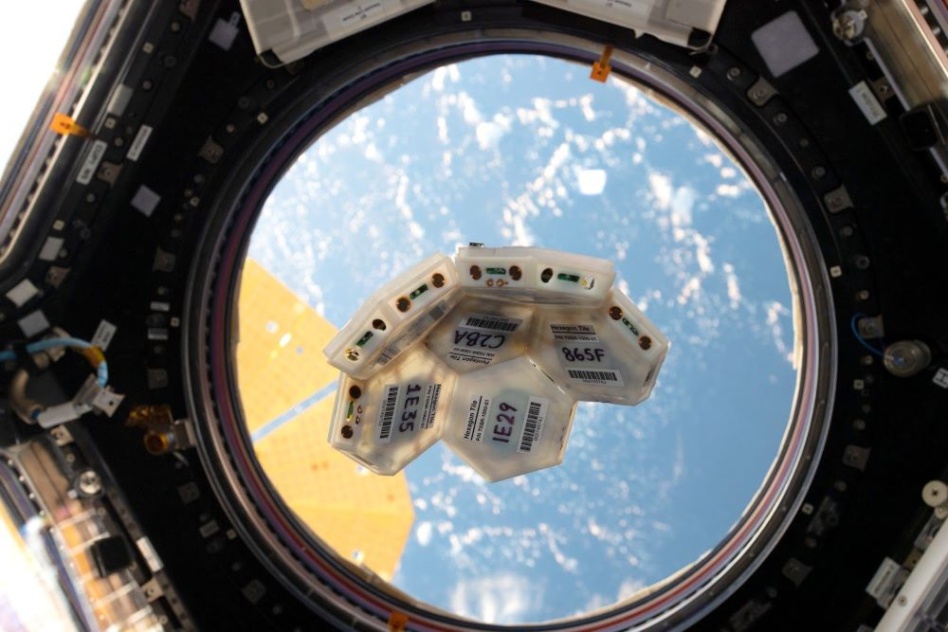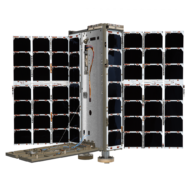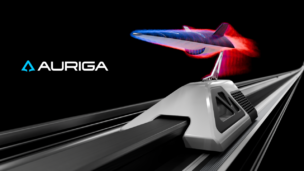Humanity has dreamed about different visions of what a civilization in space might look like for longer than the Payload team has been alive.
We’ve been planning ways to sustain human life in orbit and on other planets for decades. Now, it feels like we’re within reach of that goal—and we need to be ready for it.
The newly formed Aurelia Institute aims to prep humanity for a long-term presence in space through R&D, policy, and outreach. Ariel Ekblaw, founder of both the Aurelia Institute and the MIT Space Exploration Initiative, spends her time thinking about and designing the next generation of space stations.
Ekblaw sat down with Payload to discuss accessibility needs for human spaceflight, technology demonstrations aboard the ISS, and drawing inspiration from real life and science fiction for future space stations.
Note: This interview has been edited for length and clarity.
Why did you decide to found Aurelia in the first place?
I have led a lab at MIT for the last six years, the MIT Space Exploration Initiative. We have worked on a very broad range of artifacts for life and space, but what I saw as a gap, and something that I wanted to fill by founding Aurelia, is a focus on technology, R&D, and infrastructure for life in space. As wonderful as it is to be able to envision all of these different artifacts that we would use on the inside of a habitat, we actually still have a lot of work to do to build the habitat structures themselves in a way that will scale to allow more people to go into orbit.
The stations that we see coming online in the next few years that we all are really excited about, like Axiom or Orbital Reef, they’re still based on the International Space Station axial model with a relatively limited amount of total crew size. What I would love to do is for Aurelia to contribute in partnership or in collaboration with Axiom and Orbital Reef and NASA and others to the next generation of technology beyond ISS-like approaches. And that could be things like self assembly, or even something like artificial gravity.
The technology to develop these long-term human habitats in space is developing really quickly. How quickly do we need humanity to prepare for a long-term human presence in space? Are we going to be ready when that tech is ready?
I think we will be ready. I think we’re ready now, in a really wonderful way. The goal of democratizing access to space is to allow more people around the world to see themselves in that future. Right now, if the real estate in orbit is very small and very elite and very hard to access, then that itself is a big gatekeeper to be able to share space with a lot of people. I really do think that the time is now to begin thinking about scaling infrastructure in space. The other piece of Aurelia that complements the R&D work is trying to get more people ready and offer them a chance to really participate in the space exploration feature.
The perception I had growing up, and I think it’s a common one, is that the people who go into space have to be incredibly smart and well-educated and in incredible physical shape. Is there any truth to that perception? And how do you get that to change?
I think it was absolutely true in the past, right? It was a requirement to be able to get into the astronaut crew to be amazingly healthy, you know, top of the human population. However, that is changing.
One example of that is that we partnered with AstroAccess for several zero-G flights last year. I supported their inaugural flight in October and then we welcomed them back on our flight in May to show that we can begin to prepare space exploration and microgravity environments to be welcoming to people that may have disabilities—and also recognizing that certain things that we think of as disabilities on Earth could make people very well suited to life in space. As a concrete example, we know that our legs are very overpowered for life in microgravity. Astronauts often have to relearn not to push off too hard, because all the muscle strength that we’ve gained over a lifetime and gravity is overkill for micro-G. So folks who are in wheelchairs might find themselves particularly free and dexterous and able to move around because they don’t need legs in microgravity in the same way that they might need them on Earth.
We’ll see the beginning of everyday citizens getting to go to space. There might be some limitations on health risks, but I don’t see it being much more extreme than the typical health risks that you would go through with your doctor before doing a zero-G flight or before going on a roller coaster.
What do you have to consider from a technical perspective when building more accessible human spaceflight programs?
NASA has done an amazing job with designing the ISS for the top .001% of human talent. So the first step is to design the interior like an architect would on Earth, where you say, “Okay, what are the human users? What are their user profiles? What is their experience going to be on the station? What are their abilities or disabilities? How can we actually design the interior vernacular architecture of a space station to be able to be used by people that aren’t trained like fighter pilots or PhD mission specialists?”
Aurelia is working on building TESSERAE, a self-assembling, modular space station that sprung up from your PhD thesis at MIT. Why is it that something like TESSERAE could allow for more people to live and work in space than something like the International Space Station?
The modules for the ISS are prefabricated on Earth, which means that you have to have a rocket big enough to fit that whole module in. That means that the module can be no bigger than the biggest rocket. With something like TESSERAE, you can design tiles that pack flat in the rocket, like Legos or Ikea furniture. Once those tiles are released in orbit to stochastically self-assemble, you can build a sphere, or essentially a buckyball, that is much bigger than that biggest rocket payload fairing. The bigger the structure, the more occupancy. We have many years of work to be able to really convert TESSERAE into habitat-ready technology, but it’s something we’re working on.
TESSERAE had a technology demonstration on Ax-1, the first private astronaut mission to the ISS. Tell me a little bit about what you were thinking about going into that mission, and what you were able to learn from those experiments.
We were thrilled to be part of Ax-1. It’s a historic mission, a fully private mission to the International Space Station. It was a really good fit for us as well, with the goals that we have around democratizing access to space.
What we tested was a miniature platform—the TESSERAE tiles, about the size of my palm, that allowed us to assess whether our electronics or the custom magnets that we designed to be the joints of the structure and the hardware are working in our theoretical conception or not. So we were actually able to get sensor data about how these tiles are assembling or disassembling in microgravity. And then that informs the next iteration towards a human scale tile.
Can you share anything about how that demonstration went on Ax-1?
We actually just got a bunch of great results, which we’re very excited about! We were able to demonstrate a successful, autonomous assembly. With no human in the loop, two tiles are able to come together, dock, and form a perfect, good bond. We actually saw that happen with up to three tiles across just a matter of seconds.
We also saw two tiles come in where they don’t quite bond right, but they have enough sensing on board to detect that on their own, again autonomously, and they pulsed off, which is great because these are the corrective maneuvers that we need to see.
The third thing we were wondering is, with this many magnets packed into a small space of say, a partial dome of tesserae, would our sensors pick up on that density of magnetic field as an error and close the tiles away when actually they’re happy and they’re in the dome? We were really happy to see that after a dome was manually assembled by one of the astronauts that was helping us with the experiment, it stayed stable, which was really great. It means that the combination of our electronic sensing and the magnet polarity map is working really well.
Amazing—congratulations! What’s the next step after that demonstration?
One of the next steps in this technology roadmap would be to test more tiles. The Ax-1 test was only seven. We would love to test a full 32 title set, which is what’s required to form an entire closed buckyball. The second goal is to go bigger, which means we probably have to leave the cocoon of the International Space Station for testing and actually deploy a system off of a CubeSat in orbit, that still contains the tiles in some way because we don’t want them flying really far off away from each other, but allows us to deploy more tiles.
Are you working on development for the next stages of this project now?
We’re actually working on two things in parallel. We’re working on the next stages of development for the TESSERAE project, and we’re starting Aurelia on will be the next project after TESSERAE. So we’re doing a trade study where we’re assessing over 50 different space habitat concepts from science fiction and real demonstrated ideas, and choosing between something like artificial gravity or something like an origami or inflatable station.
Why do you need to do the trade study before picking the next project?
There’s been decades of really amazing work in space habitat conceptual design, and so we want to make sure that we’re not reinventing the wheel and that we’re also being really respectful of all of the amazing shoulders on which we stand. We’re standing on the shoulders of giants, as they say.
The trade study helps us assess the trade offs between different concepts. How many separate launches worth of material does it take to create a TESSERAE habitat at scale vs. an artificial gravity habitat or vs. an origami habitat? What are the costs of those three different models? How much total interior breathable air can you get at a certain volume with these different models?
What do you mean when you say you’re pulling from sci-fi space station concepts? Is it possible we’ll end up with a Death Star out there somewhere?
We do have a rule within the team, and we try to pull from utopia. So no Death Star from us!
When we pull from science fiction, we do think a lot about the interior design of artifacts—a lot from Star Trek. For the actual scale of space structures. I’ve been really inspired by two different books. One was Seveneves by Neal Stephenson, where they convert the ISS into this amalgam kind of growing, expanding structure. They also have this notion of little modular spacecraft called “arklets” that can dock and separate and dock and separate for reconfigurable space architecture. The second science fiction inspiration, really a longtime inspiration for me, is Ringworld by Larry Niven.
A lot of our work is inspired by the NASA 1975 Summer Study, where they pulled together a bunch of really interesting people and developed this report about the future of space architecture. It’s where those photos of what looks like 1960s, 1970s suburbia inside of a space habitat of some sort—a lot of Gerry O’Neill images, Wernher von Braun-inspired images. So that’s kind of a crossover between science fiction and planned for reality but never built.




